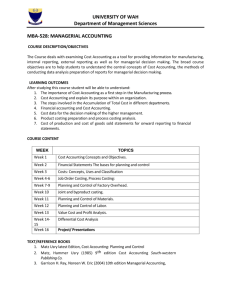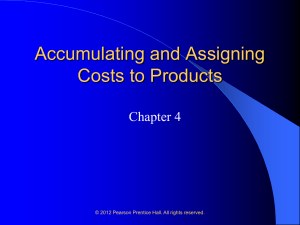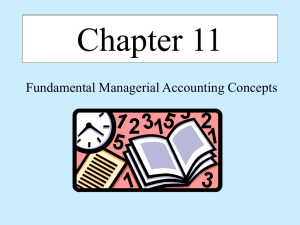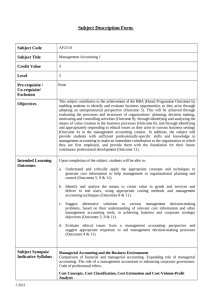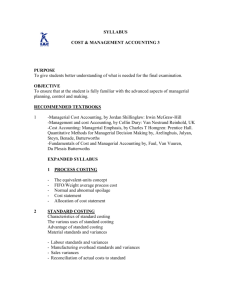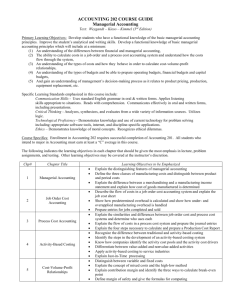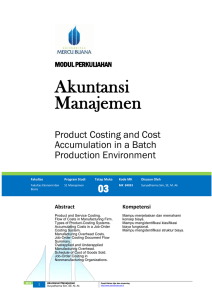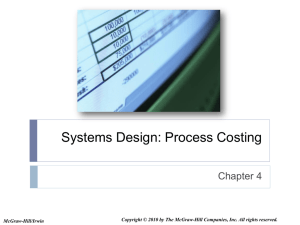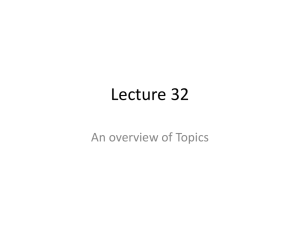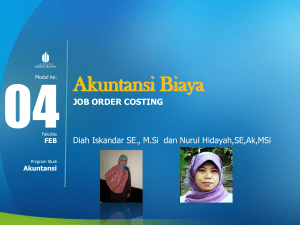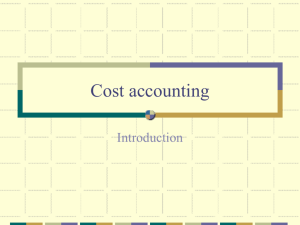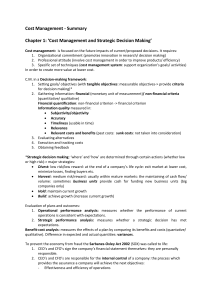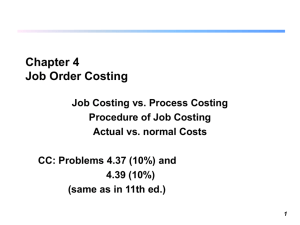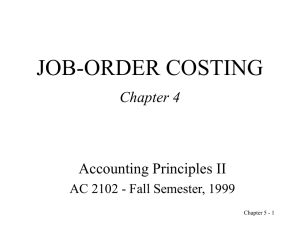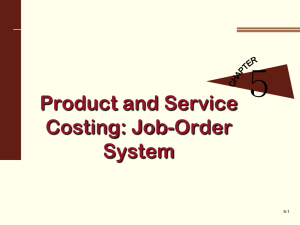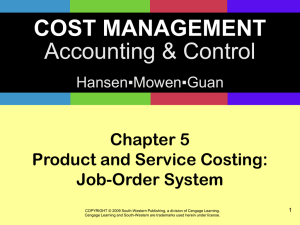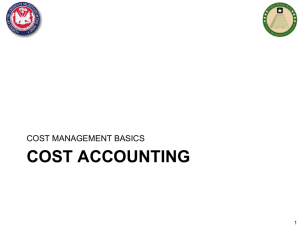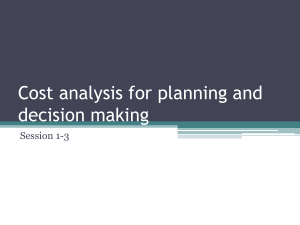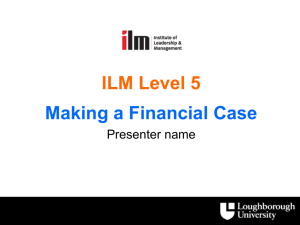Lesson 6: Accounting for Merchandising Activities
advertisement
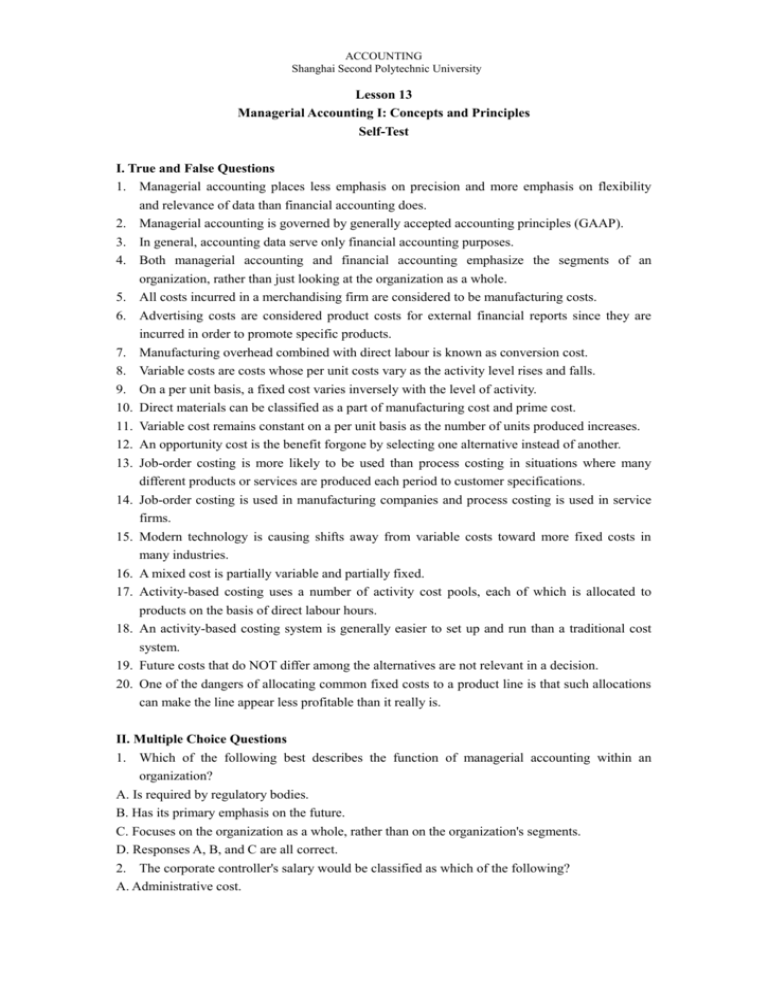
ACCOUNTING Shanghai Second Polytechnic University Lesson 13 Managerial Accounting I: Concepts and Principles Self-Test I. True and False Questions 1. Managerial accounting places less emphasis on precision and more emphasis on flexibility and relevance of data than financial accounting does. 2. Managerial accounting is governed by generally accepted accounting principles (GAAP). 3. In general, accounting data serve only financial accounting purposes. 4. Both managerial accounting and financial accounting emphasize the segments of an organization, rather than just looking at the organization as a whole. 5. All costs incurred in a merchandising firm are considered to be manufacturing costs. 6. Advertising costs are considered product costs for external financial reports since they are incurred in order to promote specific products. 7. Manufacturing overhead combined with direct labour is known as conversion cost. 8. Variable costs are costs whose per unit costs vary as the activity level rises and falls. 9. On a per unit basis, a fixed cost varies inversely with the level of activity. 10. Direct materials can be classified as a part of manufacturing cost and prime cost. 11. Variable cost remains constant on a per unit basis as the number of units produced increases. 12. An opportunity cost is the benefit forgone by selecting one alternative instead of another. 13. Job-order costing is more likely to be used than process costing in situations where many different products or services are produced each period to customer specifications. 14. Job-order costing is used in manufacturing companies and process costing is used in service firms. 15. Modern technology is causing shifts away from variable costs toward more fixed costs in many industries. 16. A mixed cost is partially variable and partially fixed. 17. Activity-based costing uses a number of activity cost pools, each of which is allocated to products on the basis of direct labour hours. 18. An activity-based costing system is generally easier to set up and run than a traditional cost system. 19. Future costs that do NOT differ among the alternatives are not relevant in a decision. 20. One of the dangers of allocating common fixed costs to a product line is that such allocations can make the line appear less profitable than it really is. II. Multiple Choice Questions 1. Which of the following best describes the function of managerial accounting within an organization? A. Is required by regulatory bodies. B. Has its primary emphasis on the future. C. Focuses on the organization as a whole, rather than on the organization's segments. D. Responses A, B, and C are all correct. 2. The corporate controller's salary would be classified as which of the following? A. Administrative cost. ACCOUNTING Shanghai Second Polytechnic University B. Product cost. C. Manufacturing cost. D. Selling expense. 3. The cost of fire insurance for a manufacturing plant is generally considered to be which of the following? A. Variable cost. B. Period cost. C. Product cost. D. All of the above. 4. Which of the following would NOT be considered a period cost? A. The salary of the company president's secretary. B. Depreciation of a machine used in manufacturing. C. Sales commissions. D. The cost of a general accounting office. 5. The salary of the president of a manufacturing company would be classified as which of the following? A. Product cost. B. Direct labour. C. Manufacturing overhead. D. Period cost. 6. Manufacturing overhead consists of which of the following? A. All manufacturing costs. B. Indirect materials but NOT indirect labour. C. All manufacturing costs, EXCEPT direct materials and direct labour. D. Indirect labour but NOT indirect materials. 7. Which of the following costs is often important in decision making, but is omitted from conventional accounting records? A. Fixed cost. B. Opportunity cost C. Sunk cost. D. Indirect cost. 8. Which of the following companies is most likely to use a job-order costing system rather than a process costing system? A. Fast food restaurant B. Crude oil refinery C. Shipbuilder D. Candy maker 9. In a job-order costing system, when a job remains incomplete at the end of a period, how is the amount of overhead cost that has been applied to that job treated? A. It is deducted on the Income Statement as overapplied overhead. B. It is part of the ending balance of the Work in Process inventory account C. It is closed out to Cost of Goods Sold. D. It is transferred to Finished Goods. 10. What is a cost driver? ACCOUNTING Shanghai Second Polytechnic University A. It is the largest single category of cost in a company. B. It is a factor that causes variations in a cost. C. It is a fixed cost that cannot be avoided. D. It is an indirect cost that is essential to the business.
